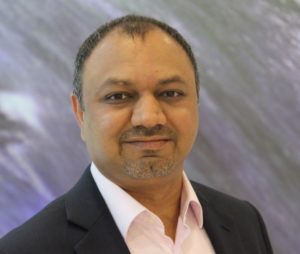
Black & Veatch is a global leader in building critical human infrastructure in energy, water, telecom and government services, catering to over 100 countries since 1915. It has completed renewable energy projects in countries as diverse as South Africa, UK, India, Thailand, Hong Kong and Indonesia. Globally, Black & Veatch has supported the development of 25 GW of solar energy and 26 GW of wind energy. Mitesh Patel, Director, Renewable Energy, Black & Veatch Asia & EMEIA, recently appointed as renewable energy director for the Asia and EMEIA regions, speaks to T&D India on Black & Veatch’s distributed energy business—current operations and future plans.
Let us start by getting an overview of B&V’s activities in the distributed energy systems space.
We offer distributed energy system clients end-to-end solutions: from initial conceptual studies to financing options, and full program management and project delivery.
Our focus is to offer contemporary solutions to improve the bankability of renewable energy projects in Asia, and other markets, through hybrid power systems that incorporate multiple sources of renewable energy with battery storage – and smart distribution technology – to stabilize fluctuating output from renewable energy sources.
When delivery and performance certainty is important, choosing right partners with world-class safety and quality standards offers the greatest reliability and most predictable outcomes. Our established regional experts deliver global best practice, tailored to local needs, minimizing project risks.
B&V recently won an order for a large solar-wind hybrid project. Tell us more on the order and discuss your outlook on such hybrid projects in India.
The recent win is to provide engineering expertise to IL&FS Energy Development Company Ltd’s 41-mw solar photovoltaic, wind, and battery storage hybrid project in Andhra Pradesh.
Core components of the project are 25-mw solar PV and 16-mw wind power generation systems, coupled to an optimized energy storage system. Technical services for the project are funded by a grant award from US Trade and Development Agency.
Black & Veatch’s role includes performing engineering studies to optimize the project, preparing the request for proposal documentation for the EPC provider and for original equipment manufacturers that may supply equipment for the project.
Hybrid solutions, by optimizing output and reducing variability, will improve overall reliability of renewable energy projects. Such systems can be used to serve communities where connection to the main grid is difficult. They are also suitable for industrial and commercial developments—such as data centres—that want resilient, sustainable energy supplies.
The project will help lay the ground for more widespread investment in such schemes because the scope includes developing recommendations for supportive regulatory rules and mechanisms that can facilitate the development of hybrid projects in India through the monetization of value streams.
Until relatively recently, the biggest challenge presented by intermittent renewable sources of energy has been energy storage. This was often referred to as the missing piece of the renewables jigsaw.
What do you feel the main challenges that you see with respect to inducting electricity from intermittent sources like solar and wind, into the grid?
Until relatively recently, the biggest challenge presented by intermittent renewable sources of energy has been energy storage. This was often referred to as the missing piece of the renewables jigsaw. But the efficiency of battery storage has grown significantly. At the same time the cost has fallen. So, technically and commercially, storage is emerging viable option.
Digital technology is also facilitating greater use of traditional storage technologies, such as pumped hydro. For example, Australia National University teamed-up with Black & Veatch to enable the evaluation of suitability of 22,000 sites for new pumped hydro storage/power generation infrastructure.
Utilizing B&V’s engineering and geospatial expertise the team developed a toolset which determines potential connection routes based on hydrological and topographical rules, and a model which generates high-level costs.
We created a library of schemes, allowing stakeholders to ‘pick schemes off-the-shelf’, make informed decisions and evaluate the schemes best suited to their requirements. This is an open-source project; the data will be accessible to everyone through a web portal. By sharing data, the project significantly lowers the bar to entry for pumped hydro storage projects.
As the ability to store energy matures, the challenge increasingly lies in cost effective implementation and integration of the technologies that offer real-time monitoring of ramps, peak shifting and matching of load and generation profiles.
In countries where electric vehicle (EV) uptake is becoming widespread we are seeing unprecedented market changes as EV owners begin to offer spare battery capacity, or sell unused power, to gencos and discoms.
Do you feel that energy storage systems, in conjunction with solar and wind farms, can be an effective step towards grid stability?
Definitely; on a technical level, hybrid systems have great potential for grid stabilization. Battery storage, allied to digital grid management tools, will enable a more reliable and consistent output from the combined facility by stabilizing fluctuations in output from the intermittent resources then matching load and generation profiles.
The nature of technical grid stabilization challenges will continue to evolve, however. In countries where electric vehicle (EV) uptake is becoming widespread we are seeing unprecedented market changes as EV owners begin to offer spare battery capacity, or sell unused power, to gencos and discoms. To give some perspective, it has been estimated that by 2040 India could be home to 31 million EVs.
In the broader sense however, stabilizing India’s grid is more than a technical challenge. In terms of generation capacity, India has a surplus. Yet many communities still suffer frequent power outages. Modernising the traditional transmission system and improving the financial stability of the discoms are central to addressing these challenges. This is why UDAY is so welcome. Moody’s 2017 upgrade in the outlook for India’s power sector from negative to stable, was to a significant degree based upon optimism about the ability of UDAY to improve the financial stability and operational performance of state discoms.
